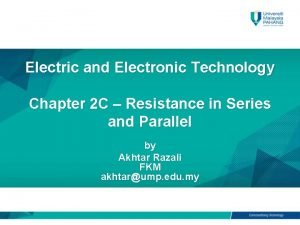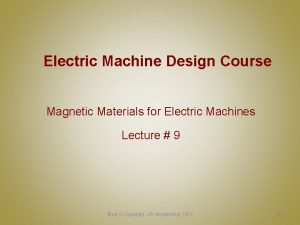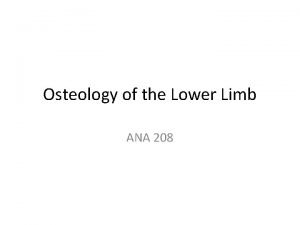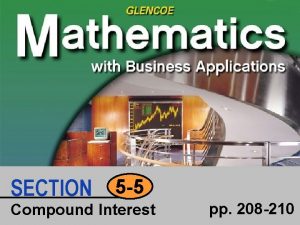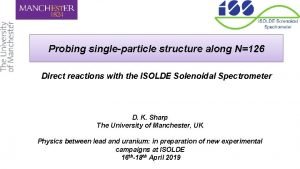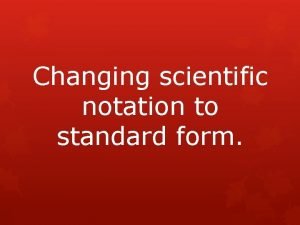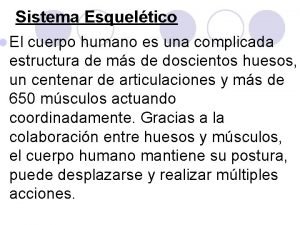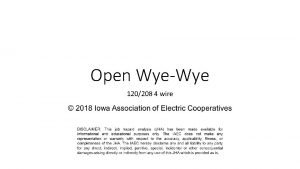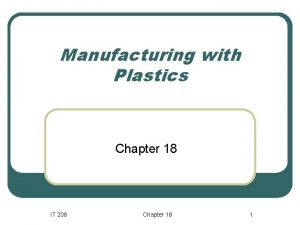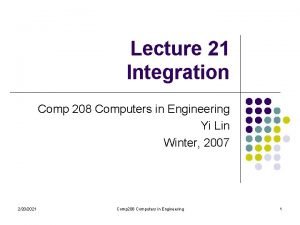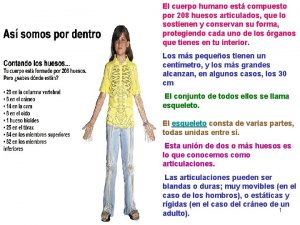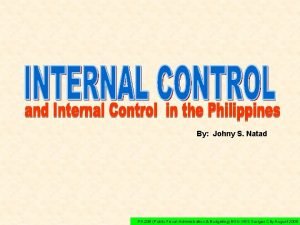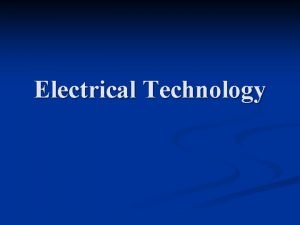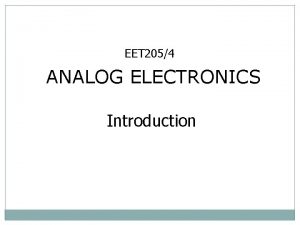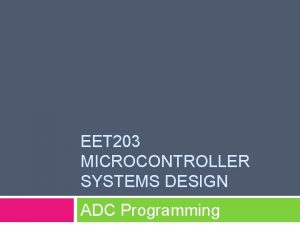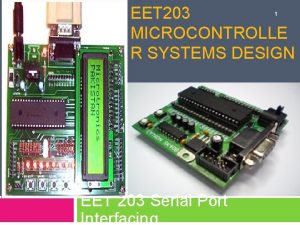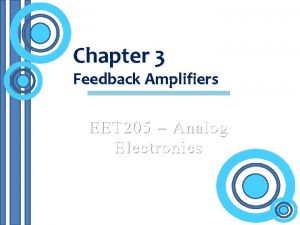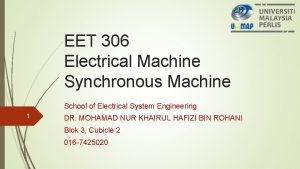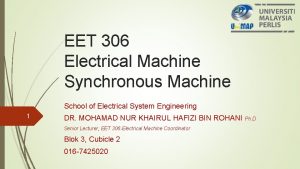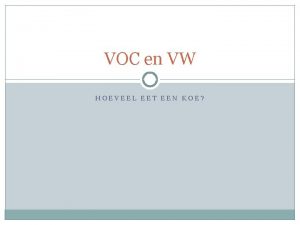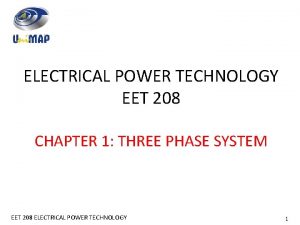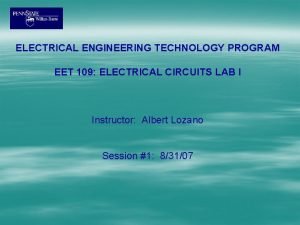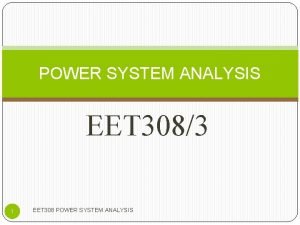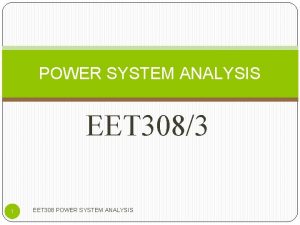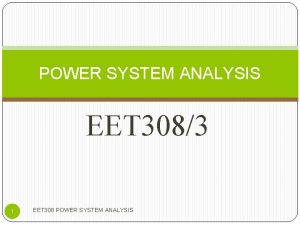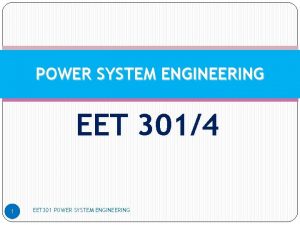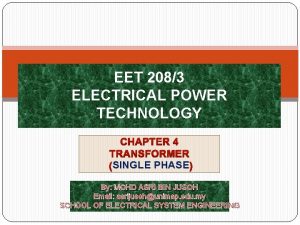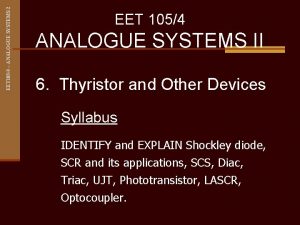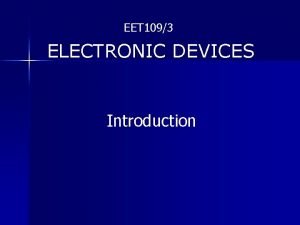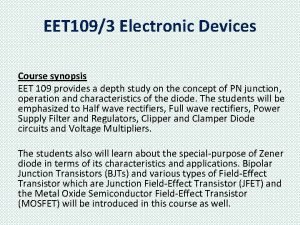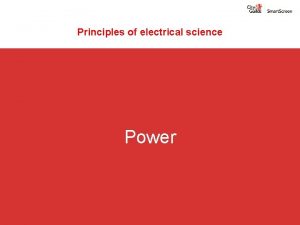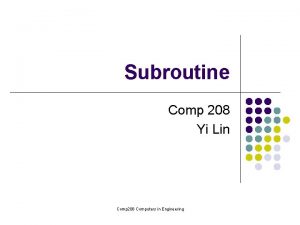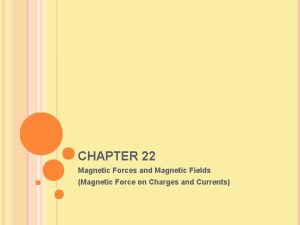EET 208 ELECTRICAL POWER TECHNOLOGY CHAPTER 3 MAGNETIC








































- Slides: 40

EET 208 ELECTRICAL POWER TECHNOLOGY CHAPTER 3: MAGNETIC CIRCUIT

INTRODUCTION TO MAGNETIC CIRCUIT q Magnetic and electromagnetic effects play an important role in the design of electrical/electronic system such as motors, generators, transformers, loudspeakers and etc. q Most of the equipment depend on magnetic effects to function properly. q There is great deal of similarity between the analyses of electric circuits and magnetic circuit. For example; -magnetic flux= current -magnetomotive force= voltage

MAGNETIC CIRCUIT Equivalent Circuit Magnetic circuit Electric circuit

COMPARISON ELECTRIC CIRCUIT & MAGNETIC CIRCUIT

MAGNETIC FIELD A magnetic field can be produced by: -- putting a current through a coil. Magnetic induction: -- occurs when a material is subjected to a magnetic field. -- is a change in magnetic moment from electrons. Types of material response to a field are: -- ferri- or ferro-magnetic (large magnetic induction). -- paramagnetic (poor magnetic induction). -- diamagnetic (opposing magnetic moment). Hard magnets: large coercivity. Soft magnets: small coercivity.

TYPE OF MAGNETISM Magnetic induction (3) ferromagnetic ferrimagnetic e. g. Fe 3 O 4, Ni. Fe 2 O 4 e. g. ferrite( ), Co, Ni, Gd (c m as large as 10 6 ) (2) paramagnetic (cm ~ 10 -4) e. g. , Al, Cr, Mo, Na, Ti, Zr vacuum (c = 0) (1) diamagnetic (c m ~ -10 -5 ) e. g. , Cu, Au, Si, Ag, Zn Strength of applied magnetic field (H) (ampere-turns/m)

EPSTEIN TEST Objective To measure power loss for electrical steel material To plot graft power loss for electrical steel material To measure leakage flux at the corner joint and limb of Baby Epstein Frame The voltage can be calculate by using the equation, V = 4. 44 BNf. A B = Flux Density, (T) in Tesla N = Number of turns f = Frequency A = Cross Sectional Area = Width x Thickness x 2 V = Average voltage, Normally Power Loss measured in W/Kg.

SINGLE SHEET TESTER Objective To know the differences of easy (rolling) or hard direction in steel strips To use the search coil as one method for measuring induced voltage To measure the nominal loss along easy and hard direction using iron loss tester The voltage can be calculate by using the equation, V = 4. 44 BNf. A B = Flux Density, (T) in Tesla N = Number of turns f = Frequency A = Cross sectional on the surface of yoke = n x t x w n = number of layer of yoke lamination t = thickness of yoke lamination [m] w = width of yoke lamination [m]

FLUX Magnetic circuit is a closed path for the passage of flux produced by the magnetic force. q The lines of force in a magnetic field are called magnetic flux whereby the total lines of force in a magnetic circuit are produced by magnetomotive force. q The general direction for the magnetic flux flow is from the North ( N ) to the South ( S ) pole. q Symbol: Φ (phi) Unit: Weber (Wb)

FLUX DENSITY The strength of the magnetic field measured by the flux density. q A good way to think about it is by measure how many Field Lines in a certain Area. q There is a stronger field at the poles where there are more field lines. q A magnetic field is often called a “B filed”. q Symbol: B Unit: Wb/m 2 or T (tesla)

FLUX DENSITY q Flux density is defined as a flux per unit area. B = flux density (T) ɸ = magnetic flux (Wb) A = area (m 2)

FLUX DENSITY Example 1 For the core in figure below, determine the flux density, B in Tesla

PERMEABILITY Permeability is the ability of a magnetic material to produce a flux in a magnetic circuit formed by a magnetisation force. q The material is said to have a high permeability when more flux can flow through it. q Symbol: μ Unit : wb/Am

PERMEABILITY Three type of permeability 1) Permeability of the material, μ. 2) Permeability of free space, μ 0 (ex: air, vacuum) q 3) Relative permeability, μr - ratio of permeability material to the permeability free space.

PERMEABILITY Ferromagnetic materials have a very high level of permeability. q Permeability of all non magnetic material (copper, aluminum, wood, glass and air) is the same as for free space. q § ferromagnetic material μr ≥ 100 § non ferromagnetic material μr = 1

RELUCTANCE Reluctance is the “resistance” to flow of magnetic flux. q In an electric circuit, resistance resists the flow of current. By analogy, in a magnetic circuit, reeluctance resists the existence of the magnetic flux. q Reluctance depends on: i- Length of material (l) ii- Cross sectional area of material (A) iii- Permeability of a material

OHM’S LAW FOR MAGNETIC CIRCUIT ɸ = magnetic flux (Wb) F = magnetomotiv force (At-ampere turn) R= reluctance (At/Wb) q The magnetomotive force (mmf), F is proportional to the product of the number of turns around the core (in which the flux is to be established) and the current through the turns of wire. F=NI (At)

OHM’S LAW FOR MAGNETIC CIRCUIT

MAGNETIC FIELD INTENSITY (MAGNETIZING FORCE) q The magnetomotive force per unit length is called the magnetic field intensity (H). q Magnetic field intensity, H is determined solely by the number of turns, N the current, I and the length of the core, l: q The flux density and the magnetic field intensity are related by the equation:

EXAMPLE 2

EXAMPLE 2

EXAMPLE 4 A coil of 200 turns is wound uniformly over a wooden ring having a mean circumference of 600 mm and a uniform cross-sectional area of 500 mm 2. if the current through the coil is 4 A, calculate (a) the magnetic field strength (b) the flux density (c) the total flux ( 1330 A/m, 1680μT, 0. 838μWb)

EXAMPLE 5 Calculate the magnetomotive force required to produce a flux of 0. 015 Wb across an air gap 2. 5 mm long, having effective area of 200 cm 2. (1492 At)

EXAMPLE 6 A mild-steel ring having a cross- sectional area of 500 mm 2 and a mean circumference 0 f 400 mm has a coil 0 f 200 turns wound uniformly around it. The relative permeability of the mild steel for the respective flux density is about 380. Calculate (a) the reluctance of the ring (b) the current required to produce a flux of 800μWb in the ring (1. 68 x 106 At/Wb, 6. 7 A)

HYSTERESIS q Hysteresis – The lagging effect between the flux density, B of a material and the magnetizing force, H applied. q The entire curve (shaded) is called the hysteresis curve.

HYSTERESIS q Normal magnetization curve for three ferromagnetic materials which are sheet steel, cast steel and cast iron

AMPERE’S CIRCUITAL LAW q Ampère’s circuital law: The algebraic sum of the rises and drops of the mmf around a closed loop of a magnetic circuit is equal to zero; that is, the sum of the rises in mmf equals the sum drops in mmf around a closed loop. Where: q By q applying the relationship for electric circuit, However, F=Hl is more practical equation for the mmf drop.

AMPERE’S CIRCUITAL LAW As an example;

FLUX q The sum of the fluxes entering a junction is equal to the sum of the fluxes leaving a junction.

AIR GAP q The spreading of the flux lines outside the common area of the core for the air gap in figure below is known as fringing. q Air gap is used to avoid saturation to occur in a magnetic material when the current flow is too high and air gap will increase the reluctance of the magnetic circuit.

EQUIVALENT MAGNETIC CIRCUIT WITH AIR GAP

EXAMPLE 7 1) 2) 3) Find the flux if the flux density is 0. 1 T. The current in the coil. The magnetic field intensity in the air gap and in the magnetic core.

EXAMPLE 7

EXAMPLE 7

EXAMPLE 7

EXAMPLE 8

SERIES-PARALLEL MAGNETIC CIRCUIT

SERIES-PARALLEL MAGNETIC CIRCUIT

SERIES-PARALLEL MAGNETIC CIRCUIT WITH AIR GAP

THANK YOU
 Electrical technology chapter 2
Electrical technology chapter 2 Types of ferrites
Types of ferrites Magnetic field strength h
Magnetic field strength h Magnetic moment and magnetic field relation
Magnetic moment and magnetic field relation Force on a charged particle
Force on a charged particle Magnetic materials used in electrical machines
Magnetic materials used in electrical machines Real power and reactive power
Real power and reactive power Ics 208
Ics 208 Ana 208
Ana 208 The plurals of nouns and articles (p. 110) answers
The plurals of nouns and articles (p. 110) answers Pl 107-208
Pl 107-208 Regex xkcd
Regex xkcd Level 2 pp. 208-210 answers
Level 2 pp. 208-210 answers Memory express
Memory express Pb-208 isotope
Pb-208 isotope What is standard notation
What is standard notation Huesos con l
Huesos con l Directional winding perm
Directional winding perm 120/208 wye wye bank
120/208 wye wye bank Plastic compression molding
Plastic compression molding 208 rmb
208 rmb Comp 208
Comp 208 208 huesos del cuerpo humano
208 huesos del cuerpo humano Pa 208
Pa 208 Dns 208 67 222 222
Dns 208 67 222 222 Define electrical technology
Define electrical technology Bet electrical technology
Bet electrical technology Electrical technology grade 12
Electrical technology grade 12 Expanding expression tool
Expanding expression tool Format email eet
Format email eet Eet 205 syllabus
Eet 205 syllabus Waar leven koalas
Waar leven koalas Eet writing test sample
Eet writing test sample Eet203
Eet203 Eet 203
Eet 203 Eet 203
Eet 203 Eet 2023
Eet 2023 Eet205 notes
Eet205 notes Eet machine
Eet machine Eet machine
Eet machine Wat eet een koe
Wat eet een koe
